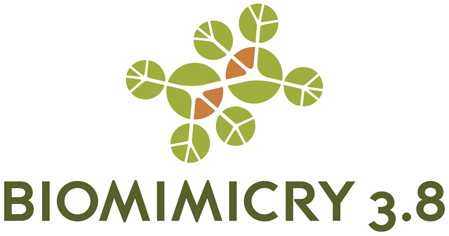Biomimicry = Return on Inspiration
How Biomimicry can help sequester carbon and build a circular economy and perfect NetPositive regenerative design
Biomimicry = Return on Inspiration
by Janine Benyus co-founder, Biomimicry 3.8 and the Biomimicry Institute
It seems so obvious now: innovators are turning to nature for inspiration in building, chemistry, agriculture, energy, health, transportation, computing–even the design of organizations and cities. Biomimicry is taught from kindergarten to university and practiced in all scales of enterprise.
But it wasn’t always this way. When Biomimicry: Innovation Inspired by Nature first came out, none of the people featured in the book knew one another, nor was there a name for their nature-inspired approach. Wes Jackson was mimicking prairies to breed a new agriculture and Tom Graedel was coding forest design principles into industrial ecology, but their parallel paths never crossed.
Twenty years later, living systems thinking is widely embraced as the antidote to the machine thinking of our first industrial revolution. Just this year, Fortune named Biomimicry a top trend; McKinsey declared the nature-inspired circular economy a game changer; and I toasted Wes Jackson’s stubborn resolve at The Perennial restaurant in San Francisco with a Long Root Ale — a brew made from his Kernsa wheat, an overwintering variety that skeptics had declared impossible.
In 2017, you can become a Certified Biomimicry Professional; get your Masters or PhD; binge watch dozens of documentaries; publish in four academic journals; or invent at more than 200 purpose-built centers such as Harvard’s Weiss Center for Biologically Inspired Engineering. Global Biomimicry Design Challenges are spawning brilliant businesses; investors are supporting what Steve Jurvetson calls a megatrend in clean tech; and regional biomimicry consultancies are popping up from Croatia to China, Chile to Chicago.
New models of product design, process engineering, packaging, and local distributed manufacturing are springing daily from bio-inspired minds. A 2010 economic study predicted that Biomimicry could represent $1 trillion of global Gross Domestic Product by 2025, and in 2012, Biomimicry topped the Society of Manufacturing Engineers’ annual list of “innovations that could change the way you manufacture.” Fortune provocated: “if you’re not incorporating the most brilliant ideas from the natural world into what you sell, you’re leaving money on the table.”
What this says to me is that the age of bio-inspired design has more than dawned—the sun is vaulting its way toward a tipping point. None of this comes too soon. In the uncharted age of the Anthropocene, Homo industrious needs a time-tested approach to healing the ruptures in our relationship with the living earth, and with each other.
I’m optimistic by choice. The trends that I see are very encouraging, including three excellent bets for investment right now: bio-inspired carbon sequestration, chemical breakthroughs to make the circular economy go round, and NetPositive policies for Generous Cities.
Biosequestration and Agriculture
One of the ripest opportunities lies in agriculture and food systems designed in nature’s image. The new quest in agriculture will be to “help the helpers,” that is, to create conditions conducive to the mutualistic organisms that actually feed and water plants, shield them from harmful sun and wind, keep them safe from pests, and encourage their growth and reproduction.
Many of these helpers live in what’s called the rhizosphere—the world around the roots—where we now know that the world’s largest mining operation occurs. Before you think belching backhoes, think flecks of mica crisscrossed by delicate fungal threads that wrap themselves around plant roots. These are the nutrient-capture systems of mycorrhizal fungi that turn soil minerals into the nutrients that plants need. Imagine a sophisticated underground system networked to find, collect, and deliver vital nutrients to its headquarters above.
It’s known fondly as the Wood Wide Web, and its health is key not only to agriculture and forestry, but to reversal of climate change as well.
When you see a patch of mushrooms, you’re only seeing part of the picture. Cobwebby fungal threads extend below mushrooms to wrap around plant roots, then extend horizontally to connect other, unrelated species into a large network. Carbon, water, phosphorus, nitrogen, and even alarm signals are exchanged. Certainly a fertilizer network any farmer would envy!
Unfortunately, tons of phosphorous and nitrogen fertilizers applied to our soils have interrupted the Wood Wide Web’s conversations, telling fungi and rhizobacteria that they are no longer needed. But in a climate changed world, these helpers are needed, not only for plant health, but for turning carbon dioxide into long-storage carbon compounds.
Healthy, microbe-rich soils can store (or biosequester) carbon at deep levels for centuries. Biomimetic agricultural practices such as ungulate-inspired managed grazing, rainforest-inspired multistrata agriculture, and prairie-inspired agriculture are the surest way to accelerate carbon sequestration.
For the latest crop of agricultural innovations, stay tuned to the teams in the Biomimicry Institute’s annual Biomimicry Global Design Challenge, the most promising of which are invited to join the Biomimicry Accelerator, where they work to bring their design to market with the help of the $100,000 Ray of Hope Prize™ from the Ray C. Anderson Foundation.
A team from the Ceres Regional Center for Fruit and Vegetable Innovation in Chile, winners of the 2016 Ray of Hope Prize, created the BioPatch, which mimics the cooperative mutualisms of the cushion plant to restore degraded soil using “helper” plants. Entire fields could be regenerated this way, creating healthy soil to sink carbon.
To stop nitrogen and phosphorous from draining off farm fields into waterways, a team from the University of Oregon developed a filtration system that took inspiration from all the ways nature grabs nutrients. Their Living Filtration System wraps fungal-infused sleeves around agricultural drainpipes (commonly used in the Midwest and in urban infrastructure) capturing nutrients in runoff that is then fed back to the plants. Over years, the system could eliminate the need for synthetic fertilizers altogether, reassembling the nutrifying, carbon-storing microbiome.
Building a Circular Economy with Bio-inspired Chemistry
If we are going to build a true circular economy, we need to create the equivalent of the Wood Wide Web. Mimicking cooperative exchange networks like this can help us ID and recoup materials and minerals in our discarded products. Then, to reassemble these into products, we’ll need to mimic how living metabolisms perform low energy, life-friendly processing–creating new products without having to mine virgin ores.
At Biomimicry 3.8, the consulting and training firm I co-founded, we’ve filed a provisional patent with a green chemistry lab and a furniture maker. It’s a biomimetic substitute for the 1.2 billion tons of polyurethane foam made every year. Currently, polyfoam is manufactured using known carcinogens, and its “take, make, waste” disposal starts right in the home — with half of the foam dissolving into chemically hazardous house dust (over ten years), and the other half destined for landfill. Luckily, the natural world is full of material models that compress and bounce back, with none of the toxic burdens and a benign afterlife that skips the landfill.
Take the time to read Janine's complete article that includes even more innovative solutions here - http://greenmoneyjournal.com/biomimicry-return-inspiration
======



